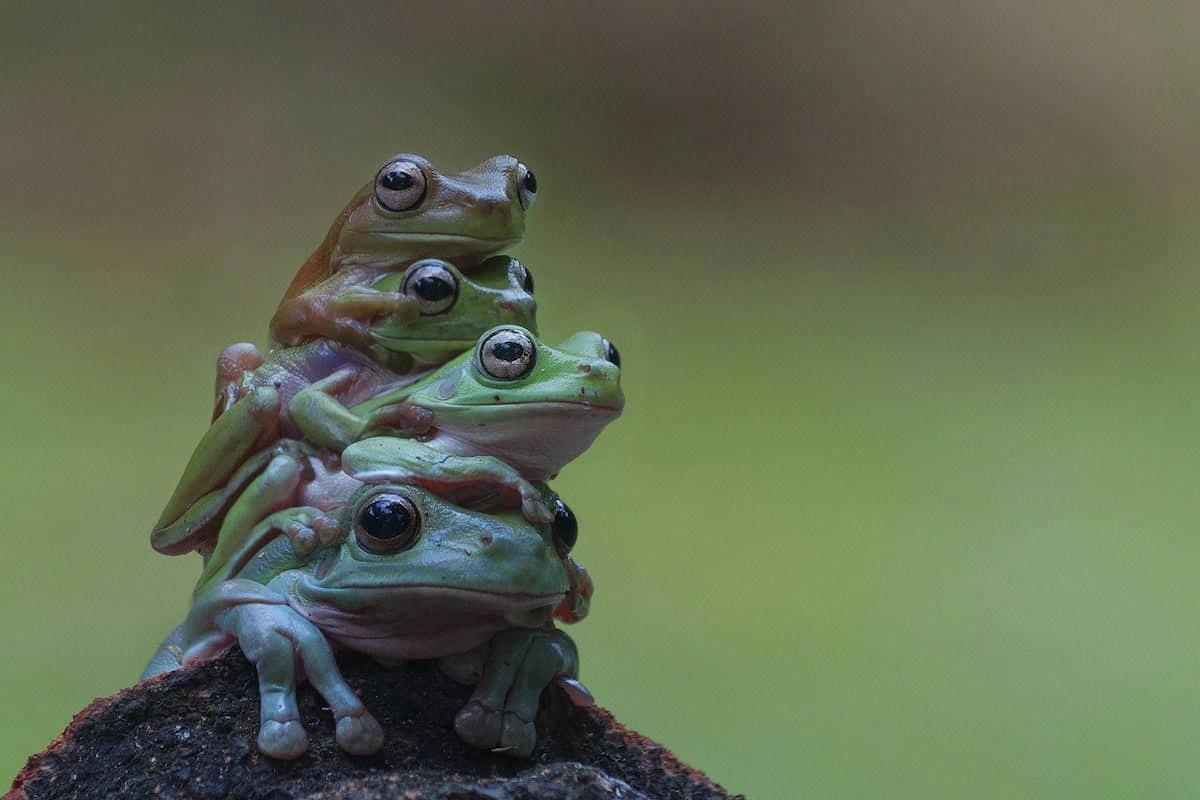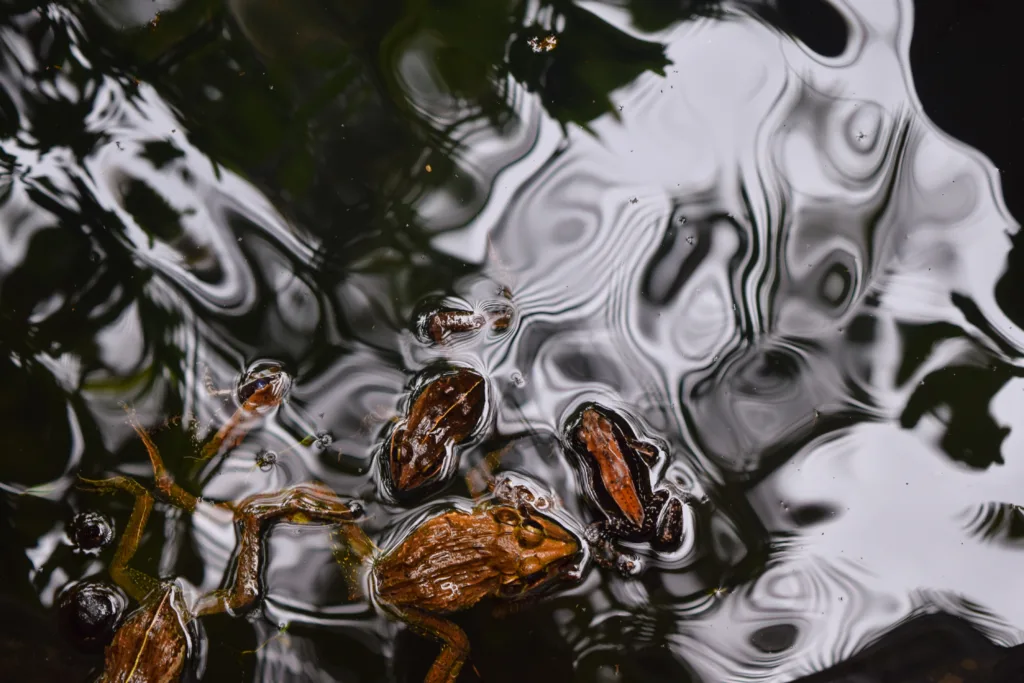Toads, those squat, rough-skinned, tailless amphibians of the order Anura, are fascinating creatures that often prefer to live solitary lives. However, on occasion, they gather together in groups, known as a knot of toads. This unique behavior is most commonly observed during their breeding season.
The term “knot” is used to describe a group of toads coming together for the purpose of reproduction. It is worth noting that the collective noun “knot” is also used to refer to a gathering of snakes during their breeding season.
During the breeding season, male toads emit a distinctive call to attract females. This call acts as a signal to potential mates and also serves to establish territories. When multiple male toads congregate in the same area, it creates a knot of toads, with each male defending his own territory.
The purpose of this gathering is for the males to compete for the attention of the females. The females will then select a mate based on various factors, including the quality of the male’s call and his ability to defend his territory.
Once the female selects a mate, the pair will engage in a unique mating ritual. The male mounts the female from behind and clasps onto her in a behavior known as amplexus. The female will then release her eggs, which the male fertilizes externally. This process is known as external fertilization.
After mating, the female will lay her eggs in water, often in ponds or slow-moving streams. These eggs will eventually hatch into tadpoles, which will undergo a metamorphosis to become adult toads.
It is important to note that the term “knot” is not the only collective noun used to describe a group of toads. Another term that can be used is a “nest” of toads. This term may be more commonly used when referring to a group of toads taking shelter together in a specific location, such as under rocks or in a burrow.
A group of toads is called a knot or a nest, depending on the context. These gatherings typically occur during the breeding season when male toads come together to compete for mates. The females select a mate based on various factors, and once mating occurs, the female will lay her eggs, leading to the next generation of toads. The behavior of toads in groups adds an intriguing aspect to the study of these fascinating amphibians.
What Is A Collective Of Toads Called?
A collective of toads is specifically referred to as a knot. This term is used to describe a group of toads when they come together. Toads, in general, are not known for gathering in large numbers, but on the rare occasions when they do, they form a knot. A knot of toads can consist of varying numbers of individuals and is typically observed during certain breeding seasons or in specific habitats.
It is important to note that the word “knot” is exclusively used to describe a group of toads, and it may not be applicable to other types of amphibians or animals. The term “knot” is unique to toads and differentiates their collective behavior from that of other animal species.

What Is A Group Of Baby Toads Called?
A group of baby toads is referred to as a knot or a nest. These terms are used to describe the gathering of young toads in their natural habitat. The term “knot” is often used to depict a cluster or a tangle of toads, while “nest” suggests a cozy and protected space where the baby toads congregate. Both of these terms are commonly used to describe the collective noun for baby toads.
What Is A Family Of Toads Called?
A family of toads is called Bufonidae. Bufonidae is a taxonomic family of squat, rough-skinned, tailless amphibians belonging to the order Anura. These amphibians are commonly referred to as toads. Toads are characterized by their unique physical features, such as their squat body shape, rough skin, and lack of a tail. They are distinct from other members of the order Anura, such as frogs, due to their specific anatomical and behavioral traits.
Toads belonging to the family Bufonidae can be found in various habitats worldwide, including forests, grasslands, deserts, and even urban areas. They have adapted to a wide range of environmental conditions, allowing them to thrive in diverse ecosystems.
Here are some key characteristics of toads in the family Bufonidae:
1. Squat body shape: Toads have a compact and stocky body structure, which distinguishes them from the slender body shape of frogs.
2. Rough skin: Their skin is typically rough and covered in warts or bumps. These skin features provide a defensive mechanism by releasing toxins when threatened, acting as a deterrent to predators.
3. Absence of a tail: Unlike some other amphibians, toads lack a tail during their adult stage. This further sets them apart from their frog counterparts.
4. Environmental adaptability: Toads in the family Bufonidae have the ability to thrive in a variety of habitats, ranging from moist environments to arid regions. They have also adapted to urban areas, making use of man-made structures for shelter.
5. Reproduction: Toads typically reproduce by laying eggs in water, where they undergo metamorphosis from tadpoles to adult toads. They often have specific breeding behaviors, such as vocalizations and courtship rituals, to attract mates.
The family Bufonidae represents a diverse group of toads with unique physical characteristics and ecological adaptability. These amphibians play important roles in ecosystems as both predators and prey, contributing to the balance of natural systems.
Why Is A Group Of Toads Called A Knot?
A group of toads is called a knot due to their tendency to gather together during the breeding season. The term “knot” is used to describe the collective behavior of toads when they come together in large numbers for the purpose of reproduction. This phenomenon is commonly observed among toads and is similar to the behavior of other animals, such as snakes, during their breeding season.
The term “knot” is specifically used to refer to the gathering of toads for breeding purposes. It is not commonly used to describe other types of gatherings or social behaviors exhibited by toads. The reason behind the choice of this term is unclear, but it likely relates to the way the toads cluster together, forming a tangled mass or knot-like shape.
It’s important to note that toads do not typically gather together in knots or groups for reasons other than breeding. They are generally solitary creatures that prefer to live and hunt alone. However, during the breeding season, toads will migrate to bodies of water, such as ponds or lakes, where they come together in large numbers to mate.
To summarize, a group of toads is called a knot because it describes their behavior of gathering together in large numbers during the breeding season. This term is specific to the breeding behavior of toads and is not commonly used to describe other social behaviors exhibited by these creatures.

Conclusion
A group of toads, although not a common occurrence, is known as a knot. This term is used to describe the gathering of many toads for breeding purposes. It is interesting to note that the collective noun of knot is also used to refer to the gathering of snakes for breeding. Toads, which are rough-skinned, tailless amphibians of the order Anura, belong to the family Bufonidae. While they typically do not gather together, when they do, it is referred to as a knot or a nest. This unique behavior adds to the fascinating characteristics of these intriguing creatures.
